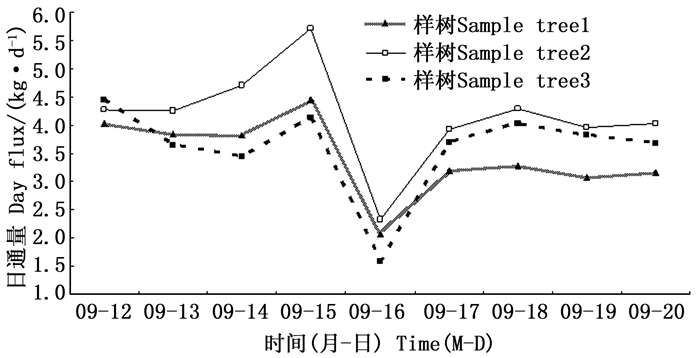-
台风是热带海洋上生成的一种强热带风暴,因其超强的风力和降雨严重影响了林业的正常可持续发展[1-2],成为我国东南部沿海的主要自然灾害之一[3]。目前,国内外很多学者研究了台风对森林生态系统的影响[4-6],但大部分集中在森林生态系统的植被结构动态[7-11]、生态水文功能[12-13]、水土流失[14]和森林恢复[15]等方面的研究,对台风过程中林木单株生理活动研究较少。林木蒸腾是林木生理活动的重要体现,是林木吸水的主要动力,定量研究植物的蒸腾耗水一直是树木生理生态学和生态水文研究的重要方向[16-17]。桉树(Eucalyptus L’Hérit.)作为我国南方的重要战略树种,其耗水研究一直是国内外研究的热点,王志超等[18]对尾巨桉(E. urophylla ×E. grandis)树干液流动态及其影响因子进行了分析,张宁南[19]研究了尾叶桉(E. urophylla S. T. Blakely)液流密度及其耗水特征,VERTESSY等[20]与WULLSCHEGER等[21]研究了王桉(E. regnans F. M.)的树干液流动态,孙振伟等[22]对柠檬桉(Corymbias citriodora Hook. f.)水分利用特征的季节动态进行了研究。由于我国桉树的种植区域多为台风高发地[23],洪奕丰等[24]研究发现,桉树是台风过程中受灾最严重的树种,其平均受害级高达2.82,受害指数高达0.56,均显著高于湿地松(Pinus elliottii Engelm.)和木麻黄(Casuarina equisetifolia Forst.),且重度受害占76.5%,因此,研究台风过程中桉树生理活动对了解桉树在恶劣环境下的适应机制具有重大意义。目前,国内对台风天气下的林木蒸腾研究较少,仅见对马尾松(Pinus massoniana Lamb.)[25]和木麻黄[26]的研究,而对台风天气下桉树人工林树干液流的响应尚未见报道。尾巨桉是桉树属最具有代表性的树种之一,广泛种植于广东、广西等地,因此,本研究在之前工作的基础上利用热扩散探针法对2年生(最易受害林龄[27])尾巨桉在整个台风过程中的树干液流进行连续观测,并同步测定各气象因子,以期揭示尾巨桉树干液流在台风天气下的响应,进而为探讨桉树人工林对恶劣环境的适应机制以及为台风降雨是否增加桉树可利用水分提供数据支持。
HTML
-
研究区位于台风高发地的广东湛江,试验地设置在南方国家级林木种苗示范基地(21°30′N,111°38′E,),属海洋性季风气候,每年平均台风1~2次,风力均在12级以上,年平均气温23℃,年降水量1 500 mm以上,多集中在5—9月份,年相对湿度80%以上,年蒸发量高达1 700 mm,基本无霜期。试验地所处地区地势平坦,属台地及低丘陵缓坡地形,螺岗岭为最高峰,海拔220.8 m,土壤为砖红壤,pH值为5.4~5.7,肥力中等。试验林地乔木层主要是尾巨桉和少量台湾相思(Acacia confusa Merr.);灌木层有鹅掌柴(Schefflera octophylla (Lour.) Harms)、白背叶(Mallotus apelta (Lour.)Muell.-Arg.)、五色梅(Lantana camara L.)等;草本层较为丰富。试验地造林树种为尾巨桉无性系32-29,造林密度1 666株·hm-2,造林时间为2012年7月,造林面积为2 hm2,造林方式为挖穴造林;其中,2年生林分的平均胸径为8.48 cm,平均树高为9.78 m,平均冠幅为3.14 m×3.6 m(东西×南北),叶面积指数平均为4.16。
-
根据中央气象台的观测结果,台风“海鸥”的中心于2014年9月16日9时40分前后在海南省文昌市翁田镇沿海登陆,登陆时中心附近最大风力13级(40 m·s-1),中心最低气压为960 hPa。2014年9月16日12时45分前后在广东徐闻南部沿海再次登陆,登陆时中心附近最大风力13级(40 m·s-1),中心最低气压为960 hPa。根据南方国家级林木种苗示范基地内桉树人工林生态系统定位研究站的气象观测场测定数据显示,15日夜间19:30时起风(风速6.22 m·s-1)后逐渐加大,到16日14:30风速达到最大(61.95 m·s-1),之后逐渐降低。15—16日2 d降水量总计为71.4 mm。
1.1. 研究区概况
1.2. 台风情况
-
在尾巨桉人工林的林外空地及林下各放置1个美国CSI-Compell公司生产的CR3000型自动气象监测系统,观测样地的各气象指标,记录频率为10 min 1次,最终换算出30 min中的平均值(降雨量为和),使之与热扩散树干液流测定仪同步;同时, 为了综合反映大气温度和相对湿度的协同效应,增加了水汽压亏缺(VPD,KPa)指标。水汽压亏缺通过大气温度和相对湿度计算得出,计算公式为:
式(1)中:RH为空气相对湿度,%;T为空气温度,℃。
-
在尾巨桉人工林固定样地内,选择生长状况良好、树干通直无挤压、无病虫害的标准木3株实施树干液流连续监测,样木的基本情况见表 1。由于样树胸径较小,茎流传感器采用2针型探针传感器(型号SF-G,探针长度33 mm,Ecomatik公司,德国),安装高度为1.3 m。为了避免树干不同方位产生的液流差异和日晒的影响,统一将探针安装在树干的北侧,且用防辐射铝箔覆盖。数据采集器采用Campbell公司的CR3000,频率为30 min 1次。液流通量密度计算公式为:
样木编号
Sample wood number胸径
DBH/cm树高
Height/m皮厚
Thickness/cm边材面积
Sapwood area/cm2树干位点高度
Trunk loci height/m测定方位
Direction1 9.6 10.8 0.3 32.9 1.3 北 2 8.3 9.8 0.2 26.2 1.3 北 3 8.7 10.1 0.2 28.1 1.3 北 Table 1. Basic conditions of the sample trees
式(2)、(3)中:Js为液流密度,指单位边材面积单位时间内的液流量(mL·h-1·cm-2);ΔTmax为无液流时加热探针与参考探针的最大温差值,ΔT为测定温差值。
2.1. 气象因子测定
2.2. 尾巨桉树干液流测定
-
分析台风前后尾巨桉树干液流(3株样树平均值)及各环境因子变化并作图。由图 1可看出:尾巨桉树干液流密度在台风登陆前及台风过后,均呈现白天高夜晚低的单峰型变化曲线,白天液流变化幅度大,夜晚较小且平稳;台风前液流峰值各日差异不大,4日平均为17.4 mL·h-1·cm-2,是台风登陆过后4日平均值的1.24倍;台风前后树干平均液流密度分别为6.15、5.38 mL·h-1·cm-2,二者差异不显著。台风当天的树干液流密度呈不规律多峰型曲线,夜晚变化幅度较大,最高峰值出现在15:30,为7.76 mL·h-1·cm-2,较台风前下降55%,其余2个较大峰值分别出现在7:30和22:30,分别为4.56、3.42 mL·h-1·cm-2,台风当天树干平均液流密度为2.89 mL·h-1·cm-2,较台风前减少了53%,极显著小于台风前和台风后。对台风前、中、后期白天和晚上的树干液流密度分别进行方差分析,结果表明:台风当天,白天的树干平均液流密度(3.53 mL·h-1·cm-2)极显著小于台风前(9.86 mL·h-1·cm-2)和台风后(8.01 mL·h-1·cm-2),而晚上的树干平均液流密度(2.17 mL·h-1·cm-2)极显著大于台风前(1.26 mL·h-1·cm-2)和台风后(0.88 mL·h-1·cm-2)。台风前后白天差异不显著,但晚上台风前显著大于台风后。台风期间主要环境因子的变化情况表现为:台风当天,降雨集中达55.4 mm,风速最高达61.95 m·s-1,平均风速达35.15 m·s-1,空气相对湿度保持在81.2%以上,三者均极显著大于台风前后;水汽压亏缺最高为0.56 KPa,太阳辐射波动较小,最高峰值只有60.72 W·m-2,大气温度一直在23.8℃和27.7℃间波动,范围变小,三者在台风当天的平均值均极限显著小于台风前后;而台风前后之间的气象指标除风速台风后显著大于台风前外,其他各指标间的差异均不显著。
-
对台风前后及台风过程中树干液流及各气象因子指标(以30 min尺度)作Pearson相关分析,结果(表 2)表明:台风前树干液流密度与太阳辐射、空气湿度、水汽压亏缺及风速呈极显著正相关,相关系数分别为0.874、0.937、0.921、0.506,与空气相对湿度呈极显著负相关(相关系数-0.923),与降雨量呈显著负相关(相关系数-0.122)。在台风过程中,树干液流密度与太阳辐射相关不显著,与空气温度、水汽压亏缺及风速呈极显著正相关(相关系数分别为0.472、0.396、0.768),与台风前相比,除与风速的相关系数增大52%外,与其他气象因子的相关系数均下降较大;与空气相对湿度呈极显著负相关(相关系数-0.388),较台风前下降58%;与降雨量呈显著负相关(相关系数-0.312),是台风前的2.6倍。台风过后,树干液流密度与各气象因子间的关系与台风前相同,各相关系数除降雨量外均有少许下降,但差异不大。
项目
Index太阳辐射
Solar radiation空气温度
Air temperature相对湿度
Relative humidity水汽压亏缺
Vapor pressure deficit降雨量
Rainfall风速
Wind speed台风前Before typhoon landfalling 0.874** 0.937** -0.923** 0.921** -0.122* 0.506** 台风过程中Typhoon period 0.140 0.472** -0.388** 0.396** -0.312* 0.768** 台风后After the typhoon 0.864** 0.914** -0.864** 0.853** -0.139* 0.223** Table 2. The correlation coefficients between sap flow density of E.urophylla×E.grandis and meteorological factors before, during and after the typhoon
-
由图 2可看出:3株样树在台风当天的液流通量均维持在较低水平。通过方差分析发现:台风当天,3株样树的日通量均极显著小于台风前和台风后(P<0.01)。台风前,样树1的液流日通量(4.03 kg·d-1)极显著大于台风后(3.18 kg·d-1),而台风后,样树2和样树3的液流日通量虽比台风前有所下降,但不显著。
3.1. 环境因子和树干液流密度的变化
3.2. 树干液流与环境因子的相关性
3.3. 台风过程对尾巨桉水分利用情况的影响
-
对雷州半岛2年生尾巨桉人工林在台风前后与台风中天气下的树干液流研究表明:台风前后尾巨桉树干液流密度均呈昼高夜低的单峰曲线,而台风当天呈不规律多峰型曲线,夜晚出现2个较大峰值,通过分析得出,晚上峰值出现的原因是多个气象因子综合影响的结果,其中,水汽压亏缺、温度和风速在峰值时刻均出现较大峰值,而相对湿度恰恰相反。台风当天,树干平均液流密度极显著小于台风前和台风后,最高峰值出现在下午,峰值较台风前下降55%,液流日通量较低,极显著的小于台风登陆前后,这与郑怀舟等[25]对台风天气下马尾松树干液流的研究结果相似,原因是较低的太阳辐射和空气温度,减弱了植物的蒸腾动力,同时,较高的空气湿度导致水汽压亏缺减小。晚间的树干平均液流密度极显著大于台风前和台风后,原因是台风当天晚上较大的风速加速叶片周围的空气流动,加大了蒸腾拉力,较大的降雨量使土壤水分含量增加,促进林分蒸腾;而白永会[26]对沙地木麻黄台风天气下液流明显提高的研究结果与本文相反,这可能是沙地土壤含水量较少,台风较大的降雨量增加了土壤含水量,从而较大促进了其蒸腾作用,或与其本身生物学特性有关,具体原因还需进一步求证。
台风天气下的剧烈环境变化使桉树树干液流与气象因子的关系也发生了较大改变,台风当天树干液流密度与太阳辐射不显著相关,原因是较小的日均太阳辐射(12.9 W·m-2)产生的蒸腾动力对液流影响较小,而台风天气下较大的风速加速了叶片周围水汽交换,反而成为影响液流的最关键因子,相关系数较台风前显著增大,较大的降雨量很大程度增大了空气湿度、降低了大气温度,使水汽压亏缺显著减小,从而较大的抑制了树木的蒸腾,因此,树干液流密度与降雨量的相关(负相关)系数较台风前后显著增大,而与其他气象因子(大气温度、相对湿度和水汽压亏缺)的相关系数均显著下降。
对台风前和台风后的树干液流密度对比发现:日平均液流密度、白天平均液流密度,台风前后均差异不显著,而晚上的平均液流密度台风前显著大于台风后。台风前树干液流密度峰值是台风后的1.24倍。3株样树的液流日通量在台风后均有所下降,其中,样树1台风后液流日通量极显著的小于台风前,而样树2和3在台风前后液流日通量差异不显著,造成这种结果的原因推测可能是台风对枝叶的机械损伤造成的。台风对林木的损害,如枝叶脱落、树干折断甚至连根拔起[28-29],这些机械损伤严重影响林木蒸腾。另外,土壤含水量增加在一定程度上又促进林木蒸腾[30],因此,推测台风前后的蒸腾差异是否明显,由包括林木机械损伤程度在内的多个因素决定的,还需进一步的研究求证。
-
对台风天气下的尾巨桉树干液流的研究表明,台风天气下的液流特征较台风前后均有较大差异,台风当天树干液流密度呈不规律多峰型曲线,而台风前后均是昼高夜低的单峰曲线,且台风当天的日均液流密度、液流峰值、白天的平均液流密度和日通量均极显著小于台风前和台风后,而夜间的液流密度显著大于台风前和台风后;台风前的日均液流密度与台风后差异不显著,夜间液流密度台风前显著大于台风后;台风过程中,风速成为影响液流的关键因子,与太阳辐射相关不显著,其他影响因子与台风前后相同,但相关系数除风速和降雨量外均显著下降。

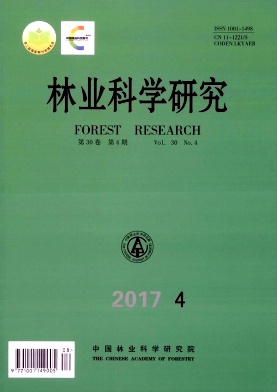


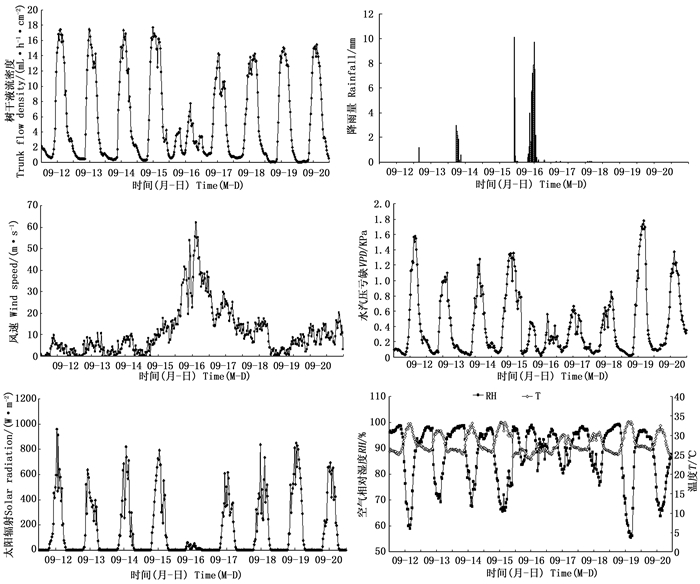

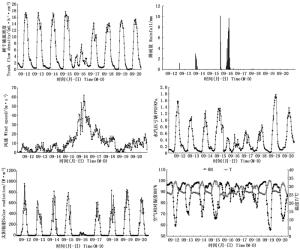
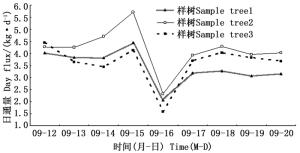
 DownLoad:
DownLoad:
